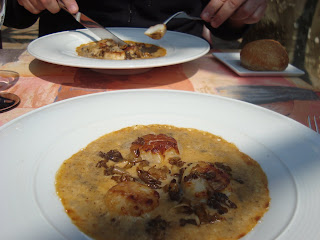It was my first time ever to taste base wine, and I soon realised how this can give you a clear indication of how the final style of the champagne will be. It was extremely interesting to compare the vin clairs with the champagne; minerality found in one would also be present in the other, austere acidity in one would also be the end result in the final Champagne. What was also very interesting to see and understand was the change in style from father to son or daughter. Most of the producers were represented by two generations and the styles of the wines were distinctive according to which one produced it. The main idea behind this tasting is the focus on terroir in Champagne. Unfortunately, Champagne is mostly associated with blends of different areas and therefore of different soils which doesn’t give a clear terroir identity. Whilst these 17 producers try to keep the connection with soil and terroir as much as possible; 30 different soils being represented in this tasting.
The brains behind this project are Berec and his friend Aurélien Laherte of Laherte Frères who brought together not only 17 high quality producers but also different areas of Champagne, again to bring forward the diversity of terrior. The stars of the day were: Pascal Agrapart, Françoise Bedel, Raphaël Bereche, Francis Boulard (Raymond Boulard), Alexandre Chartogne (Chartogne-Taillet), Couche Vincent, Pascal Doquet, Jean-Baptiste Geoffroy (René Geoffroy), Etienne Goutorbe (Henri Goutorbe), Cyril Jeaunaux (Jeaunaux-Robin), Benoît Lahaye, Aurélien Laherte, David Léclapart, Franck Pascal, Olivier Paulet (Hubert Paulet) Fabrice Pouillon and Benoît Tarlant.
From these great producers one cannot pick favourites, yet I feel that producers like Pascal Agrapart, Pascal Doquet, Franck Pascal and the famous Benoît Tarlant, need a special mention. Pascal Agrapart’s wines come from 3 different terroirs from the same village of Avize. Venus, named after his horse which he uses for ploughing his soils, is one of the most mineral and delicate Champagnes I ever tasted. A remarkable point made by Pascal was that he uses cork not a bidule as his bottles are ageing sur latte, because this gives a delicate ageing edge to his wines.
Situated in Vertus and producing bio wines since 2003, Pascal Doquet’s Le Mensil Champagne coming from the Grand Cru Le Mensil-sur-Oger in the Cote de Blancs, has a unique nose of mature fruit, toasty aromas and an almond elegant finish.
Last but not least, actually I think the most well-known of the 17 producers¸ Benoît Tarlant. From the heart of the village of Oeuilly, just bordering the river Marne, Tarlant has been producing Champagne since 1687. Introducing Cuvee Louis Extra Brut from his vineyard in Les Crayons, Benoit told us he calls this Champagne the river wine. The river which helps keep the grapes cool giving highly concentrated fruit yet a pure and delicate nose with crisp acidity; all feature in this lovely champagne. A 50/50 blend of Chardonnay and Pinot Noir from 60-year-old vines, based primarily on the 1998 harvest with reserve wines from both 1997 and 1996.
Well, after I posted my photos from Champagne on my Facebook page, one of my friends told me, “I think you're in heaven!!” and I cannot possibly disagree. Yet Champagne has been only one of the heavenly regions I visited lately. I hope to discover more in the near future.































